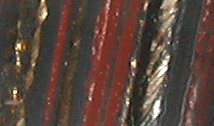
September Editorial

September Editorial
Rocks which tell of the Oxygen Catastrophe |
|
As we become more and more aware about climate change due to mankind pumping carbon dioxide and other gasses into the atmosphere, it is sometimes asked how easy it is for such changes to destroy life on Earth. Here we will tell one story from the distant past of Earth's history, in which climate change left life on Earth hanging by a thread. The story begins 2.5 billion years ago in a period known as the Paleoproterozoic era. At this time, the Earth's atmosphere was rich in methane and although oxygen was plentiful, it was not a constituent of the atmosphere but bound up in water molecules. Life on Earth consisted only of bacteria. The methane-rich atmosphere trapped the heat from the sun creating a greenhouse effect well suited to the development of these microorganisms. Among them was a green-blue algae called cyanobacteria. Cyanobacteria was the very first life form to use water and the sun for photosynthesis, aprocess which produced free oxygen as a waste product. At this time the sea was not as we know it now. It was rich in iron, which gave the ocean a distinctly green colour. Free oxygen released by cyanobacteria reacted with the iron molecules in the water, which resulted in iron oxidation. The iron oxide was much heavier and settled on the bottom of the ocean, slowly depleting the water of iron. Once the iron in the oceans was oxidized, free oxygen started to leak into the atmosphere slowly breaking down the methane. The sun was much cooler at this time, and with the depletion of methane there was nothing to keep the temperature up. The temperature started to drop and eventually plummeted to about -50oC. This was the Earth's first ice age. The corrosive oxygen in the atmosphere and the low temperatures quickly took their toll and most life on earth disappeared. Not even cyanobacteria could survive in these conditions, and it too almost became extinct - a victim of its own success. But a few life forms deep in the ocean survived and cyanobacteria itself hung on, though in vastly reduced numbers. The bacterial survivors of the catastrophe evolved and adpated themselves to an oxygen-rich atmosphere which they learned to utilise to produce CO2. Over millions of years oxygen from the atmosphere was partially replaced by this carbon dioxide, warming up the Earth once again and bringing life back to what had been icy wastes. Nowadays our only reminder of this unsettling time in the Earth's history are rocks which were once on the ancient ocean floor. These are layered with oxidized iron - relics of that time of massive iron oxidisation. Over many millions of years these processes of precipitating silica and iron oxide were repeated over and over again, and resulted in the deposition of alternating layers of chert (which is grey), hematite (which is red) and magnetite (which is black). Thus, the name banded iron formation comes from the characteristic colour banding of these huge deposits, which are well known in Western Australia. |
| _______________________________ | ||||
| Home | | | Shopping | | | Database |
© Biscuit Software 2004-2015
All rights reserved